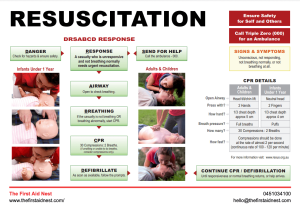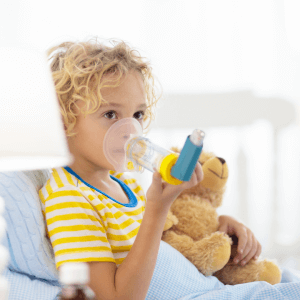Allergic Reaction In a Baby

The rate of childhood allergy has risen exponentially over the last few decades.
One study showed that in 1960, 3% of people worldwide had food allergies and in 2018, 7% of people had food allergies. This is not just the rate of people, it is also the range of foods that people are now allergic to.
The rate of food allergy in babies is now 10%. That’s 1 in 10 babies! It’s an epidemic of its own now. This is also only the babies we know about, some may have food allergies out there but have not yet been seen by a doctor or been diagnosed.
3-5% of children still have their food allergy by school age.
Allergic Reaction on a Baby
There is a myth that children and babies can only react to certain foods, but actually, anyone can have a reaction to any food at any time. As children get older, it is unlikely that they develop new allergies, and their chance of growing out of them becomes less likely.
There are 9 foods that are responsible for 90% of food allergies:
- Wheat
- Egg
- Milk
- Soy
- Peanuts
- Tree nuts
- Fish
- Shellfish
- Sesame
These are the foods that are in bold on the back of packets. This is often a legal requirement depending on the country.

How would you know if your baby is allergic to a food before you give it?
Unfortunately, there is no way of knowing if your child has a food allergy until you give the food and the reaction happens.
We don’t recommend people rub the food on the child’s skin or the outside of the lip first, as this may well cause the skin to go red or the lip to swell slightly, but this does not tell us if they have a true allergy when the food is ingested.
How do I introduce the Allergy food?
There is no one specific way to introduce a common allergy food, but there are some recommended practices.
Introduce one food at a time, or you can use things like ABC paste (almond, brazil, cashew) if this makes life easier for you and your child is not high risk for allergies.
Introduce common allergy foods as early as possible, between 4-6 months or when your child is ready to eat. Research shows this helps to reduce the rate of childhood allergy.
Introduce food gradually if you feel nervous about giving them to your baby. Here is one strategy you can use:
- Give ⅛ tsp
- Wait 30 mins
- Give ¼ tsp
- Wait 30 mins
- Give ½ tsp
- Wait 30 mins
- Give 1 tsp
- Watch the child closely for an hour.
- Continue to give 1-2 tsp of the food for the next 4-5 day
You must continue to give the food for 4-5 days in a row and then keep the food in the diet weekly if possible.
Which children are high risk for food allergies?
Babies with eczema or a strong family history of food allergy are at higher risk for food allergies, but this just means it is even more important to introduce those foods early on.
What does an allergic reaction look like?
When a baby eats a common allergy food, we know there is always a risk of an allergic reaction, but how would you know?
Signs and symptoms of a mild/moderate allergic reaction in babies:
- Swelling of the lips, face, eyes
- Hives or welts
- Tingling mouth
- Abdominal pain &/or vomiting
Signs of a severe allergic reaction
- Difficult or noisy breathing
- Swelling of the tongue
- Swelling or tightness in the throat
- Wheeze or persistent cough
- Difficulty talking or hoarse voice
- Pale and floppy

How to respond to an allergic reaction in a baby
If your baby has symptoms of a mild/moderate allergic reaction:
- Remove the food from the baby.
- Source your baby first aid kit and use age appropriate anti-histamine. Check which ones your baby may be able to have with your local pharmacist or GP.
- Wipe your babies hands and mouth to avoid any further contamination.
- Watch your baby for the next 1-2 hours and monitor symptoms.
- Take pictures of the symptoms
- Book an appointment with your doctor to seek further advice. They may need to be referred to a paediatric immunologist for skin testing
If your baby has symptoms of a severe allergic reaction:
- Remove the food from the baby
- Call an ambulance
- If you have an Epipen, administer immediately – then call an ambulance
- Monitor your child closely until help arrives
- If your baby stops breathing normally at any time – start CPR
*Anti-histamine will not stop symptoms of anaphylaxis
If your baby has a severe allergic reaction, you must get a referral for a paediatric immunologist. They need a full consultation with skin prick testing and yearly follow up. Please check that your allergy doctor has skin prick testing facilities. Some doctors with an interest in childhood allergy will only want to do blood tests, but this is not best practice
Baby First Aid Course
Our baby first aid courses are available as in-home courses, public courses or as a pre-recorded online course which you can access anytime and complete self-paced, and we also have the option of a live group online class.
We run classes in your home with groups of 2, 4 or up to 10 in Sydney & Melbourne and you can book in 3 easy steps!
- Pick your class
- Follow the prompts to purchase
- We will contact you within 24 hours to lock in your date of choice
Here are some other resources you may enjoy!
- FREE GUIDE: Introducing Common Allergy Foods & Allergic Reactions
- Book a baby & child first aid class in your home
- Online Baby & Child First Aid


